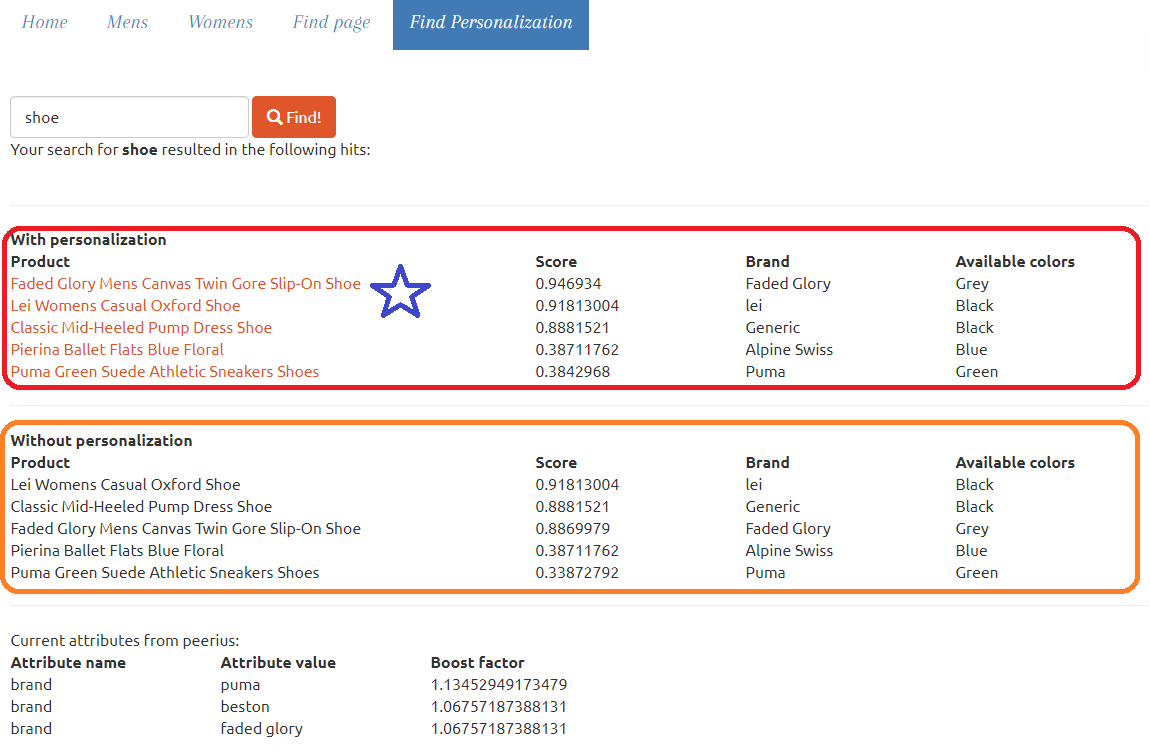Personalized Search & Navigation
Describes the native integration for Optimizely Search & Navigation, and how to work with search attributes and values provided with the search client to boost search hits.
Personalized Search & Navigation (formerly Personalized Find) is a personalization service you can add to Optimizely Search & Navigation as part of the Optimizely Personalization product suite.
NotePersonalized Search & Navigation currently only works with Optimizely Commerce Connect.
Packages
In addition to Episerver.Find, these packages are needed for the extension:
EPiServer.Personalization.Commerce– Integration for product recommendations.EPiServer.Find.Personalization– Search & Navigation integration components.
Extension components
Personalized Search & Navigation fetches attributes from a personalization service containing a list including property name, property value, and boosting. The list is included as “boosting” with the Search & Navigation service when searching or filtering content.
The boosting changes the generated “score” on content, to make the result personalized. Depending on the query and what attributes return from the personalization service, this functionality will have a different impact on the result.
Configure
To enable retrieval of search attributes, configure the Attribute API. The required attributes are episerver:personalization.Site and episerver:personalization.ClientToken. See Optimizely Product Recommendations for information about configuring the Recommendations API.
Retrieve attributes
The Recommendations API must fetch attributes before executing a personalized Search & Navigation query and store or cache them for fast retrieval before the user needs them so that latency is not adversely affected when a site visitor executes a query or filter. The following sections describe how to retrieve attributes.
Call the Refresh method
Call the Refresh method on an instance of the EPiServer.Find.Personalization.IPersonalizationClient. To retrieve the active EPiServer.Find.Personalization.IPersonalizationClient instance, call the Personalization() extension on EPiServer.Find.Personalization.IClient.
using EPiServer.Find.Personalization;
namespace OptimizelySite.Controllers {
public class MyController: PageController < MyPage > {
private readonly IClient _client;
public MyController(IClient client) {
_client = client;
}
public ActionResult Index(MyPage currentPage) {
System.Threading.Tasks.Task.Factory.StartNew(currentContext => {
System.Web.HttpContext.Current = (HttpContext) currentContext;
_client.Personalization().Refresh();
},
HttpContext.Current.ApplicationInstance.Context);
return View(currentPage);
}
}
}Decorate a controller with RefreshPreferences
Decorate a controller with an EPiServer.Find.Personalization.RefreshPreferences attribute to get attributes from the API when it executes any action method on the controller. To avoid unnecessary refreshing, check the IPreferenceRepository for attributes first, or use the controller to track if a refresh was already done for the visitor.
namespace OptimizelySite2.Controllers {
[EPiServer.Find.Personalization.RefreshPreferences]
public class MyController: PageController < MyPage > {
public ActionResult Index(MyPage currentPage) {
return View(currentPage);
}
}
}The Recommendations API call is asynchronous, so it has little effect on the time it takes to execute the controller.
After retrieval, CMS stores the attributes in an EPiServer.Find.Personalization.IPreferenceRepository. The default implementation stores the attributes in the session and a cookie for fast retrieval during or between sessions no longer than two days apart.
If you want to override the default, implement EPiServer.Find.Personalization.IPreferenceRepository and change the implementation using the conventions during initialization: IClient.Personalization().Conventions.PreferenceRepository. The interface has two methods to implement, Save and Load, which are self-explanatory.
Execute personalized search queries
To enable personalization in Optimizely Search & Navigation queries, add .UsingPersonalization() to the query on the search client. CMS scores the results according to attribute data.
Example
var result = _client.Search<ProductContent>()
.For("ferrari")
.UsingPersonalization()
.GetContentResult();Sample code
This section provides sample code for comparing search results that use .UsingPersonalization() against search results that do not. The examples use the Quicksilver Optimizely Commerce Connect sample site and the Personalized Search & Navigation APIs.
NoteRecommendations and personalized search results currently only supports Optimizely Commerce Connect content. Also, the
.UsingPersonalization()syntax only boosts Optimizely Commerce Connect content properties.
Configure the example
-
Install the Quicksilver sample site.
-
Install the NuGet packages
EPiServer.Personalization.CommerceandEPiServer.Find.Personalization. -
Add the following configuration from the
Optimizely.Personalization.Commercepackage to theweb.configfile (CMS 11) orappsettings.json(CMS 12) of the site.
-
Verify that the data tracking and recommendations work as expected.

-
Go to some product pages on the site so the personalization system can track and collect behavioral data.
-
Create a
PersonalizedFindPagepage type.namespace EPiServer.Reference.Commerce.Site.Features.Personalization.Models { [ContentType(DisplayName = "PersonalizedFindPage", GUID = "e7e5cea1-10cf-4e1a-ab36-1c922d997e28", Description = "")] public class PersonalizedFindPage: PageData { [CultureSpecific] [Display( Name = "Main body", Description = "The main body will be shown in the main content area of the page, using the XHTML-editor you can insert for example text, images and tables.", GroupName = SystemTabNames.Content, Order = 1)] public virtual XhtmlString MainBody { get; set; } } } -
Create a
PersonalizedFindPagepage view model.public class PersonalizedFindPageViewModel { public PersonalizedFindPage CurrentPage { get; set; } public bool UsePersonalization { get; set; } public IEnumerable < PreferenceAttributeData > CurrentPersonalizationAttributes { get; set; } public string SearchTerm { get; set; } } -
Create a
PersonalizedFindPagecontroller.private readonly IClient _client; private readonly UrlResolver _urlResolver; public PersonalizedFindPageController(IClient client, UrlResolver urlResolver) { _client = client; } public ActionResult Index(PersonalizedFindPage currentPage, string q, bool ? usePersonalization = null) { var viewModel = new PersonalizedFindPageViewModel { CurrentPage = currentPage, SearchTerm = q, UsePersonalization = usePersonalization.HasValue && usePersonalization.Value }; System.Threading.Tasks.Task.Factory.StartNew(currentContext => { System.Web.HttpContext.Current = (HttpContext) currentContext; _client.Personalization().Refresh(); }, System.Web.HttpContext.Current.ApplicationInstance.Context); var prefData = _client.Personalization().Conventions.PreferenceRepository.Load(); if (prefData != null) { var attributes = prefData.Attributes; viewModel.CurrentPersonalizationAttributes = attributes; } return View(viewModel); } -
Create a view for displaying the attributes.
@using EPiServer.Core @using EPiServer.Web.Mvc.Html @model EPiServer.Reference.Commerce.Site.Features.Personalization.ViewModels.PersonalizedFindPageViewModel</pre> <div>Current attributes from Personalization:</div> <table class="table"> <tr> <th>Attribute name</th> <th>Attribute value</th> <th>Boost factor</th> </tr> @if (Model.CurrentPersonalizationAttributes != null) { foreach (var attribute in Model.CurrentPersonalizationAttributes) { <tr> <td>@attribute.Name</td> <td>@attribute.Value</td> <td>@attribute.Score</td> </tr> } } </table>The view result should look like this:
Make sure the returned attributes are not empty.
Compare the search results
This example visualizes the difference between search results with and without personalization.
NotePersonalized Search & Navigation works only with free-text search queries, as described in Search.
First, add .UsingPersonalization() to the search query.
var resultsPersonalized = _client.Search()
.For(q)
.FilterForVisitor()
.UsingPersonalization()
.GetContentResult();Then, add another search query without .UsingPersonalization(), for comparison.
var resultsWithoutPersonalized = _client.Search()
.For(q)
.FilterForVisitor()
.GetContentResult();Add more properties to the model to preview the result on the front-end.
namespace EPiServer.Reference.Commerce.Site.Features.Personalization.ViewModels {
public class PersonalizedFindPageViewModel {
public PersonalizedFindPage CurrentPage {
get;
set;
}
public bool UsePersonalization {
get;
set;
}
public IEnumerable < PreferenceAttributeData > CurrentPersonalizationAttributes {
get;
set;
}
public IEnumerable < SearchResultModel > SearchResults {
get;
set;
}
public IEnumerable < SearchResultModel > PersonalizedSearchResults {
get;
set;
}
public string SearchTerm {
get;
set;
}
}
public class SearchResultModel {
public string Url {
get;
set;
}
public Uri Image {
get;
set;
}
public double Score {
get;
set;
}
public string Name {
get;
set;
}
public string Brand {
get;
set;
}
public IEnumerable < string > AvailableColors {
get;
set;
}
}
}The controller:
namespace EPiServer.Reference.Commerce.Site.Features.Personalization.Controllers {
public class PersonalizedFindPageController: PageController < PersonalizedFindPage > {
private readonly IClient _client;
private readonly UrlResolver _urlResolver;
public PersonalizedFindPageController(IClient client, UrlResolver urlResolver) {
_client = client;
_urlResolver = urlResolver;
}
public ActionResult Index(PersonalizedFindPage currentPage, string q, bool ? usePersonalization = null) {
var viewModel = new PersonalizedFindPageViewModel {
CurrentPage = currentPage, SearchTerm = q, UsePersonalization = usePersonalization.HasValue && usePersonalization.Value
};
System.Threading.Tasks.Task.Factory.StartNew(currentContext => {
System.Web.HttpContext.Current = (HttpContext) currentContext;
_client.Personalization().Refresh();
},
System.Web.HttpContext.Current.ApplicationInstance.Context);
var prefData = _client.Personalization().Conventions.PreferenceRepository.Load();
if (prefData != null) {
var attributes = prefData.Attributes;
viewModel.CurrentPersonalizationAttributes = attributes;
}
if (!string.IsNullOrEmpty(q)) {
var resultsPersonalized = _client.Search < FashionProduct > ()
.For(q)
.FilterForVisitor()
.Track()
.UsingPersonalization()
.GetContentResult();
var resultsWithoutPersonalized = _client.Search < FashionProduct > ()
.For(q)
.FilterForVisitor()
.Track()
.GetContentResult();
if (resultsWithoutPersonalized != null) {
viewModel.SearchResults = GetSearchResultModels(resultsWithoutPersonalized);
}
if (resultsPersonalized != null) {
viewModel.PersonalizedSearchResults = GetSearchResultModels(resultsPersonalized);
}
}
return View(viewModel);
}
private IEnumerable < SearchResultModel > GetSearchResultModels(IContentResult < FashionProduct > contentResult) {
return contentResult.Select(fashionProduct => new SearchResultModel {
Name = fashionProduct.Name,
Brand = fashionProduct.Brand,
AvailableColors = fashionProduct.AvailableColors,
Score = contentResult.SearchResult.Hits.First(x => x.Document.ContentLink == fashionProduct.ContentLink).Score.GetValueOrDefault(),
Url = _urlResolver.GetUrl(fashionProduct.ContentLink),
});
}
}
}The view for displaying the attributes:
@using EPiServer.Web.Mvc.Html
@model EPiServer.Reference.Commerce.Site.Features.Personalization.ViewModels.PersonalizedFindPageViewModel
<div>
@Html.PropertyFor(m => m.CurrentPage.MainBody)
</div>
@using (Html.BeginForm("", "", FormMethod.Get, new { @class = "form-inline" }))
{
<div class="form-group">
<input type="text" name="q" id="q" value="@Model.SearchTerm" class="form-control" />
<button type="submit" class="btn btn-primary">
<span class="glyphicon glyphicon-search" aria-hidden="true"></span> Find!
</button>
</div>
}
@if (!string.IsNullOrEmpty(Model.SearchTerm))
{
<h2>Your search for <b>@Model.SearchTerm</b> resulted in the following hits:</h2>
<h3>With personalization</h3>
<div class="row">
<div class="col-lg-12">
<div class="row">
<div class="col-lg-5">Product</div>
<div class="col-lg-2">Score</div>
</div>
@foreach (var hit in Model.PersonalizedSearchResults)
{
<div class="row">
<div class="col-lg-5"><a href="@hit.Url">@hit.Name</a></div>
<div class="col-lg-2">@hit.Score</div>
</div>
}
</div>
</div>
<h3>Without personalization</h3>
<div class="row">
<div class="col-lg-12">
<div class="row">
<div class="col-lg-5">Product</div>
<div class="col-lg-2">Score</div>
</div>
@foreach (var hit in Model.SearchResults)
{
<div class="row">
<div class="col-lg-5">@hit.Name</div>
<div class="col-lg-2">@hit.Score</div>
</div>
}
</div>
</div>
}
<h3>Current attributes from Personalization:</h3>
<table class="table">
<tr>
<th>Attribute name</th>
<th>Attribute value</th>
<th>Boost factor</th>
</tr>
@if (Model.CurrentPersonalizationAttributes != null)
{
foreach (var attribute in Model.CurrentPersonalizationAttributes)
{
<tr>
<td>@attribute.Name</td>
<td>@attribute.Value</td>
<td>@attribute.Score</td>
</tr>
}
}
</table>Result
The search query that uses .UsingPersonalization gives boosted results using visitor attributes and orders the search results differently.

Updated 28 days ago